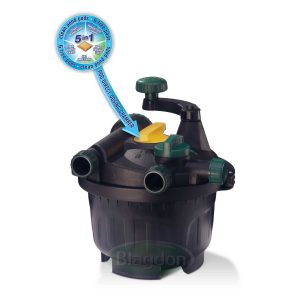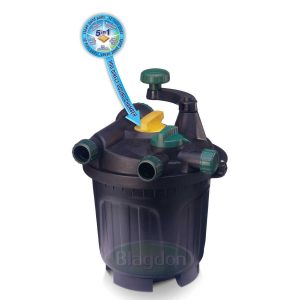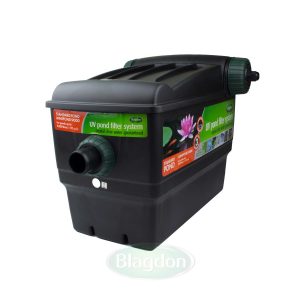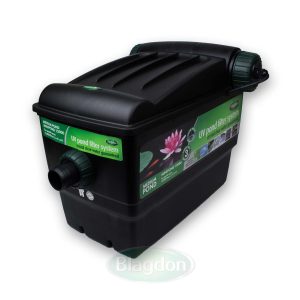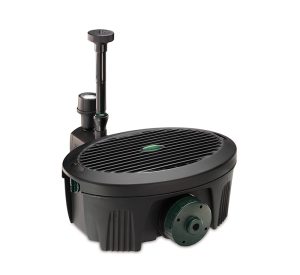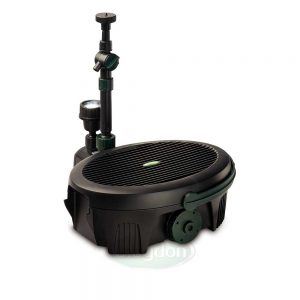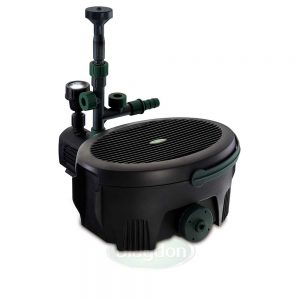Filters

Pond Filters
Keep your pond clean and healthy with our reliable selection of pond filters. Essential for maintaining the water quality in your pond by removing debris, excess nutrients, and harmful bacteria. They help to keep the water clear, reduce algae growth, and provide a healthy environment for fish and other aquatic life.
We have several pond filters available, including the Inpond 5 in 1, Clean Pond machine, and Minipond. Everything you need to keep your pond in top condition. Our filters are easy to install so you can enjoy your pond without worrying about its upkeep.
Types of pond filters
Inpond 5 in 1 filter system
This all-in-one pond solution comes with a pump, filter, UV clarifier, and LED spotlight designed to provide continuous light, along with three fountain feature heads. Offers both mechanical and biological filtration to maintain clean water. The 5 W UV clarifier effectively eliminates green water and algae, while the fountain heads add a beautiful touch to your pond.
Clean Pond machine
A convenient and efficient filtration system that ensures your pond remains spotless, all while keeping your hands clean and dry. This innovative design, free of foam, is the result of over a decade of research and development to prevent the common challenges that come with maintaining a pond.
Minipond filter
Includes a UV pond filter system to ensure crystal clear water for your pond with guaranteed results. The six-stage filter process is designed to keep your pond fresh and clear with minimal maintenance required.
Benefits of pond filters
- Improves water quality
- Reduces algae growth
- Easy maintenance
- All-in-one solutions
Have any questions? Read our Filtration FAQs for more information.
Pond Filters FAqs
How do pond filters work?
Pond filters work to keep a pond clean and healthy by removing pollutants, such as dirt, debris. They also help to improve water quality by turning toxic waste products into nitrates that can be used by pond plants for food.
A typical pond filter system consists of biological filter media and mechanical filter media to keep it healthy and often an ultraviolet (UV) clarifier to enable the filter to remove green water algae.
Some all in one filters also come with their own pump to circulate the water through the filter. The majority of external filters need a separate pump in the pond to supply water to the filter system before it is returned to the pond.
Why is a filter necessary?
Without proper filtration, a pond can quickly become an unhealthy environment for your fish. Poor water quality is the primary reason for fish losses , and will also affect wildlife in the pond .Pond filters also create better water clarity by removing debris. Removing debris from the pond with a filter will also mean the need to clean out or vacuum the pond will be reduced. UV clarifiers combined with the mechanical filtration will stop your pond looking like green pea soup.
What filter do I need for my pond?
The filter you need depends on the volume of your pond.
There are several types of filters, such as:
- Inpond filters: Installed inside the pond and use a pump to draw water through a filter media.
- External box filters: Installed outside the pond. A pump is needed to supply water to the filter. Water passes through a UV Clarifier, then uses gravity to pass the water through the filter media and return it to the pond. The outlet from the filter must be positioned above the water level, or a waterfall in order for it to drain the water in the filter under gravity.
- Pressure filters are installed externally and fed with water from the pond by a pump. As the filter inlet and outlet hose is fed under pressure from the pump the filter can be installed above or below the level of the pond water. As the outlet hose is also under pressure from the pump it can be sent to a higher point like a waterfall.
- Ultraviolet clarifier: UV clarifiers help to reduce algae by introducing ultraviolet light into the water, this coagulates the algae into clumps large enough for mechanical filter media to capture. Most filter systems have a integrated UV clarifier. However some large pond filters may no . A pond of a very large volume may need several large separate UV clarifiers to achieve water clarity.
Whichever filter you choose, make sure it’s designed for your specific pond type and size.
Do I need a UV clarifier?
UV clarifiers help manage algae green water growth, exposing water to a special ultraviolet light. This helps to effectively eliminate green water algae. It is not possible for any pond filter mechanical media to catch single cell green water algae without a UV clarifier.
Where should a pond filter be placed?
If using an in pond filter it should be placed as close to the deepest part of the pond as possible to ensure that water can be efficiently filtered.
Depending on the type of filter you are using, you may need to install additional equipment such as a pump, piping or hoses to connect the filter with other components in your system.
Ensure there is enough clearance around the filter so it can operate without obstruction
You can position your filter in any convenient location adjacent to your pond. Note that longer runs of pipe work from the pump to the filter, and for pressure filters from the filter back to the pond or waterfall will dramatically reduce the flow of your pump. So do try to keep pipework length and lift to a minimum. Please take into account the length and height of filter pipework when selecting the correct pump for your pond filter.
What tips should I keep in mind when maintaining a pond filter?
Proper maintenance is key to keeping your pond filter working properly. Here are some tips to help ensure your filter runs optimally:
Only clean your filter when the water flow has visibly reduced by a third to a half. Mechanical filter media needs to partially block to improve its efficiency at removing suspended solids in the water. Cleaning a filter too often will not help, but probably hinder fast and effective filtration.
For gravity filter which overflow the mechanical media when blocked. Clean the filter media when one third to a half of the water is overflowing and therefore bypassing the mechanical filter media.
UV lamps need replacing annually. In order to get the best from your new lamp, replace it in the spring so it is at peak performance through the spring and summer when the pond receives the most daylight.
Open cell foam media can get tired and hard to clean after 12-24 months. If it’s lost its bounce and will not clean easily replace it. .
How often should you change pond filters?
The frequency of filter media changes will depend on the type of filter you have and the size of your pond. Generally, it is recommended to clean or replace internal filters every few months and external filters every 6 to 12 months.
Pressure filters may need to be cleaned more often. It’s also important to monitor the water quality in your pond regularly and make sure that any clogs or build up is removed.
Can I use two filters in my pond?
If you have a large pond, it is a good idea to use two filters in order to provide more thorough filtration. Having two filters also helps to reduce the amount of time needed to clean and maintain your system. Make sure the two filters are installed at different depths within the pond so that all water can be filtered.
How do I clean my pond filter?
Depending on the type of filter you have, there are several methods for cleaning it.
For internal filters, start by turning off the pump and disconnecting any hoses or pipes connected to the filter. Then, remove the filter media from the filter housing and rinse it thoroughly in water to remove any debris.
If the filter has a manual backwash feature, activate this to help flush out dirt and debris from the filter housing. Once the filter is clean, reinstall it and turn on the pump.
For external filters, start by turning off the pump and disconnecting all hoses and pipes connected to the filter. Remove any debris from around the filter housing. Then use a garden hose to clean the filter media. This should be done regularly to ensure efficient filtration and healthy water for your pond.
If you’re looking for an expert pond filtration system, the Clean Pond Machine 7000 is an ideal solution. This foam-free pressurised system is hassle-free with crystal clean water guaranteed.
For more information, please see our Filtration Q&As.



